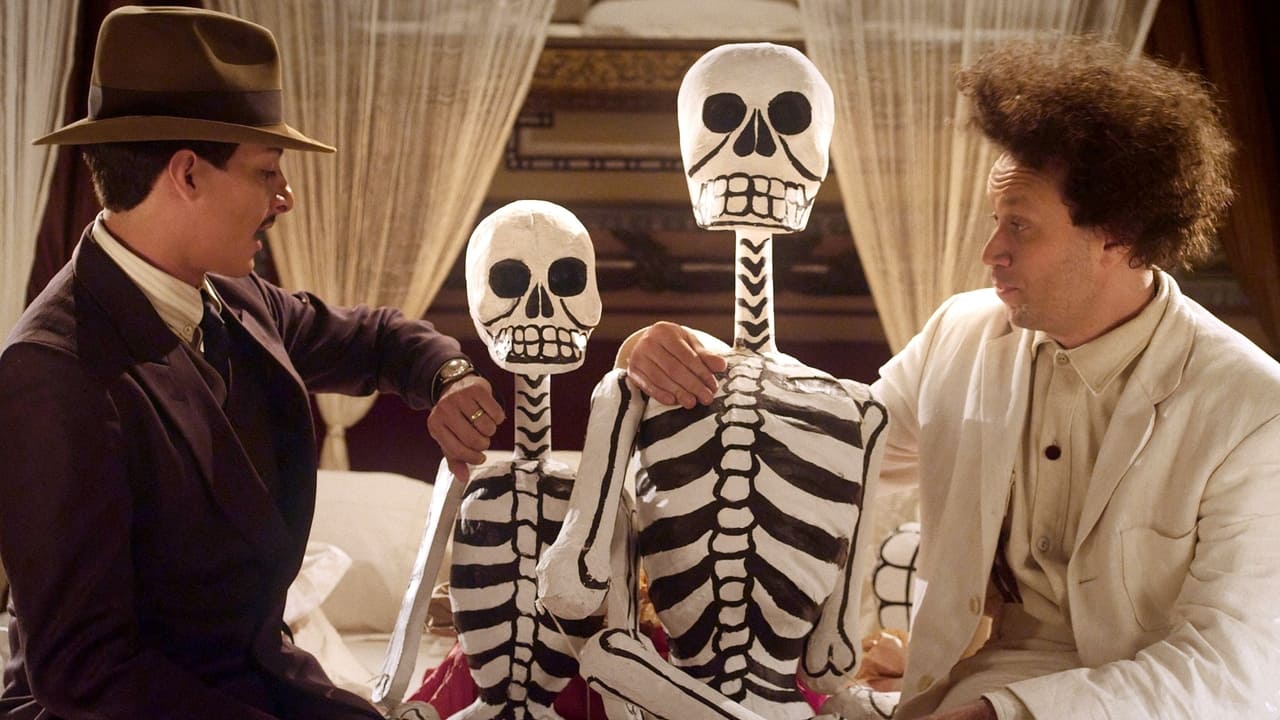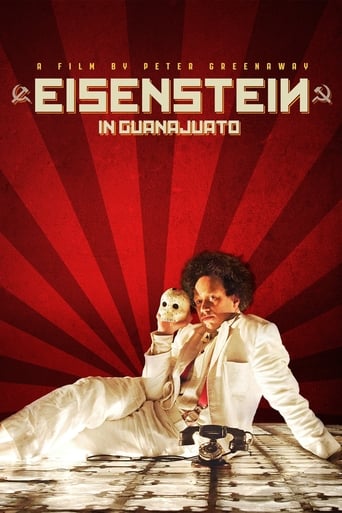



Takes itself way too seriously
Nice effects though.
The film's masterful storytelling did its job. The message was clear. No need to overdo.
View MoreNot sure how, but this is easily one of the best movies all summer. Multiple levels of funny, never takes itself seriously, super colorful, and creative.
View MoreAs the title indicates, this is a biopic inspired by the Mexican days of Soviet Union cinema vanguard Sergei Eisenstein (1898-1948), after his sortie into Hollywood proved to be futile, in 1930, he was assigned to make the ambitious but ultimately problematic project QUE VIVA MEXICO in Mexico (the whole ordeal is worthy of its own screen re-enactment), which Eisenstein would later relinquishes, a relatively intact version would only be released posthumously in 1979. No one would expect Peter Greenaway's treatment to be strictly reverent, although now in his seventies, Greenaway has no hesitation of venturing into the prurient facet of Eisenstein's idiosyncrasy and abandon, preponderantly, the film is a two-hander between Sergei (Bäck) and his Mexican guide Palomino Cañedo (Alberti), to whom Sergei claims to lose his virginity. Sergei's homosexual initiation is explicitly explored in the palatial hotel room he stays, on that vast bed, the sex temple he shares with Palomino, and coins the first ten days in Guanajuato as "Ten Days that shook Eisenstein", a wordplay to his revolutionary pièce-de-résistence OCTOBER: TEN DAYS THAT SHOOK THE WORLD (1928). Greenaway delights in magnifying Eisenstein's blunt self-reflection and directorial frustration (although it is mostly an interior piece that largely overlooks the filmmaker's onerous field work, excluding a visit to the Mummies of Guanajuato and the institution of the Day of the Dead celebration) through his larger-than-life approach which constitutes operatic ways of utterance, info-dumping sleight-of-hand where real-life footage is rapidly juxtaposed to counterpoint the references in a triptych split-screen, and majestic, but noticeably digitally airbrushed and light-inflected scenography, being put into great use in the flourishes of 360 degree twirling shots and seamlessly edited faux-long shots, etc., all is impressive on a grandiose scale, but also appreciably betrays an overreaching effort to reassure us that he is still at the top of his game.Under the spotlight is Finnish actor Elmer Bäck's madcap impersonation of a ludic, unprepossessing Eisenstein, sporting a fuzzy, bouffant hairdo à la Einstein, and gives his all to Greenaway's undue caprices, which on the whole leaves the impression that Eisenstein is more hysterical than sympathetic, a clownish figure whose brilliance is very much elusive to moderately stunned audience, a typical case of miscast should be noted. Luis Alberti, by comparison, comes off less scathed owing to his more natural and unaffected "stud" role in the play. By and large, Greenaway's self-reflexive, symphonically flamboyant opus can be construed as a nonconformist filmmaker's knowing salute to a free-spirited genius who constantly clashes with his times and whose legacy should be incessantly exhumed to meet new light and fresh air, and knock dead any number of spectators.
View MorePeter Greenaway's career is beyond any ambitions of commercial success - his most successful (audience-wise) movies were made in the 80s. Even then the combination of colors and music, architecture (he is an architect by formation) and composition, his obsessions for sex and death and his bluntness in approaching them were much out of the beaten track. For the last two decades his projects became more and more exploratory, with the moving images being only one of the tools in combinations of multi-disciplinary explorations and experiments that brought together almost every artistic discipline that was invented. Eisenstein in Guanajuato can be seen almost as a return to the more conventional tools of film making. It has a story, and it has a hero and it has a theme, one of these themes film makers love to bring to screen, maybe the ultimate film theme - film making! If you listen to what Peter Greenaway has to tell about his film (and he speaks a lot as he promotes the film in the international festival tour) Eisentein in Guanajuato is before all a homage to one of the greatest directors in the history of cinema who was Sergei Eisenstein. It also is a social and political commentary, as it deals with what was probably the most exuberant, liberal and care-free period in the life of the screen director of the Soviet Revolution, and also with the sexual orientation of Eisenstein which was kind of a well known secret in his biography, tolerated by the Soviet authorities but maybe also a tool of blackmail by the KGB. The period spent by Eisenstein in Mexico while shooting material never gathered and edited for a film about the country and its revolutions may have been the happiest time in the life of the director already famous for Potemkin and October. It allowed him not only a unique encounter with a culture that was so different from some aspects yet so close from other compared with the Russian culture he knew from home, but also an encounter with himself, with his own demons, his self-denied homosexuality, his tendency to the luxury and the decadence of the bourgeois life, so different from the austerity he left in the Soviet Russia and to which he was condemned to return.There is almost nothing in this film about Eisenstein's film making. At no point does he shout 'Camera!' or 'Action!' - at some moment he even refuses to do so. Peter Greenaway does not try to expose any secrets of the film making art of Eisenstein, but rather deals with the surrounding context that made his films possible. Finnish actor Elmer Bäck brings on screen an Eisenstein who hides his doubts behind exuberance, and his fears behinds carelessness, who is sure of his artistic genius but unaware about his personal charisma. Mexican actor Luis Alberti builds a fine counterpoint to Eisenstein's character and a credible gay love interest. The camera work does not try to replicate anything that Eisenstein has done on screen, but rather quotes and incorporates fragments of Eisentein's movies with the visual commentaries of Greenaway. I read some critical opinions about viewers 'getting tired' by the too intense camera work - I do not agree with them. When what you see on screen is expressive and interesting you cannot get tired, as one does not get tired of seeing more masterpieces in an art museum, or of listening to fine opera or classical music. Sets are as exuberant and as complex as an architect mind like Greenaway's can conceive. Overall Eisenstein in Guanajuato was for me a very satisfying and surprisingly entertaining experience.
View MoreNew Peter Greenaway movie about Russian movie-maker Eisenstein's Mexico odyssey in 1931, when he went there to make a documentary with the financing of famous writer Upton Sinclair and ended up with 400km of film reel he was never allowed to edit. According to the movie, comrade Eisenstein, as a closet homo, also lost his (anal) virginity there, at age 33...and the scene where it happens is quite graphic.I'm not a fan of Greenaway but this movie proved to be very enjoyable as long as you don't take it too seriously. It is not a traditional biopic, being quite experimental and with constant over-the-top intensive dialogue. Some visually beautiful scenes and inventive camera work and framing. It also has quite a lot of emotional and even existential depth.Right at the beginning, when we are introduced to all the main characters, Greenaway shows photos of real historical figures in a split scene with actors portraying them...it must be said every one of them looks surprisingly similar to the real thing. For me as a Estonian it was pretty funny to hear all the Russian characters speaking English with Finnish accent (apparently for Greenaway as a Briton this sounded close enough to legit Russian accent so he had Finnish Swedes playing all the Soviets). Elmer Bäck as Eisenstein is fantastic in this movie and pretty much carries it on his own at times.Homophobes are advised to avoid this one like a plague though.
View MoreWhen I was waiting for the movie to start, I was wondering why so many gay couples had come in to see it. However this was all explained as soon as the movie started.This film indeed is not about Eisenstein making a film (we see very little to nothing of that), or about his time in Mexico: except for some beautiful shots of nature and some dead masks and philosophical bladibla which has been taken totally out of context and are never truly deepened, there is little to no true interaction with Mexican culture. All conversations except for a very small amount are in English.No, this movie is all about the male body and, to put it frank, gay anal sex. Yes, indeed the butt-loving Eisenstein receives from his Mexican guide Cañedo is probably his most profound encounter with the Mexicans, and for the rest of the movie the two characters do little else than run around naked with their willies flopping up and down. Other characters do appear in the movie but get no real chance at any story or development. The prime example of this are the American brother and sister who barge into Eisenstein's hotel room towards to end of the movie. This is actually the moment that the viewer discovers that Eisenstein has already been in Mexico for 8 months shooting a movie with American funding, something quite essential but completely discarded during the first part of the picture.The most annoying part of the film was certainly the vertiginous camera work. In the scene in the hotel room just described, the camera spins for about 5 minutes around the bed with a half-naked Eisenstein in it. I had to actually close my eyes as I felt the whole scene was making me sick. The vomiting and diarrhea scenes at the start of the movie had already done the same thing.In other words, for those profoundly into male nudity and gay cinema, I would recommend to go and see this film; otherwise, you'll probably have some other place you'd rather be.
View More